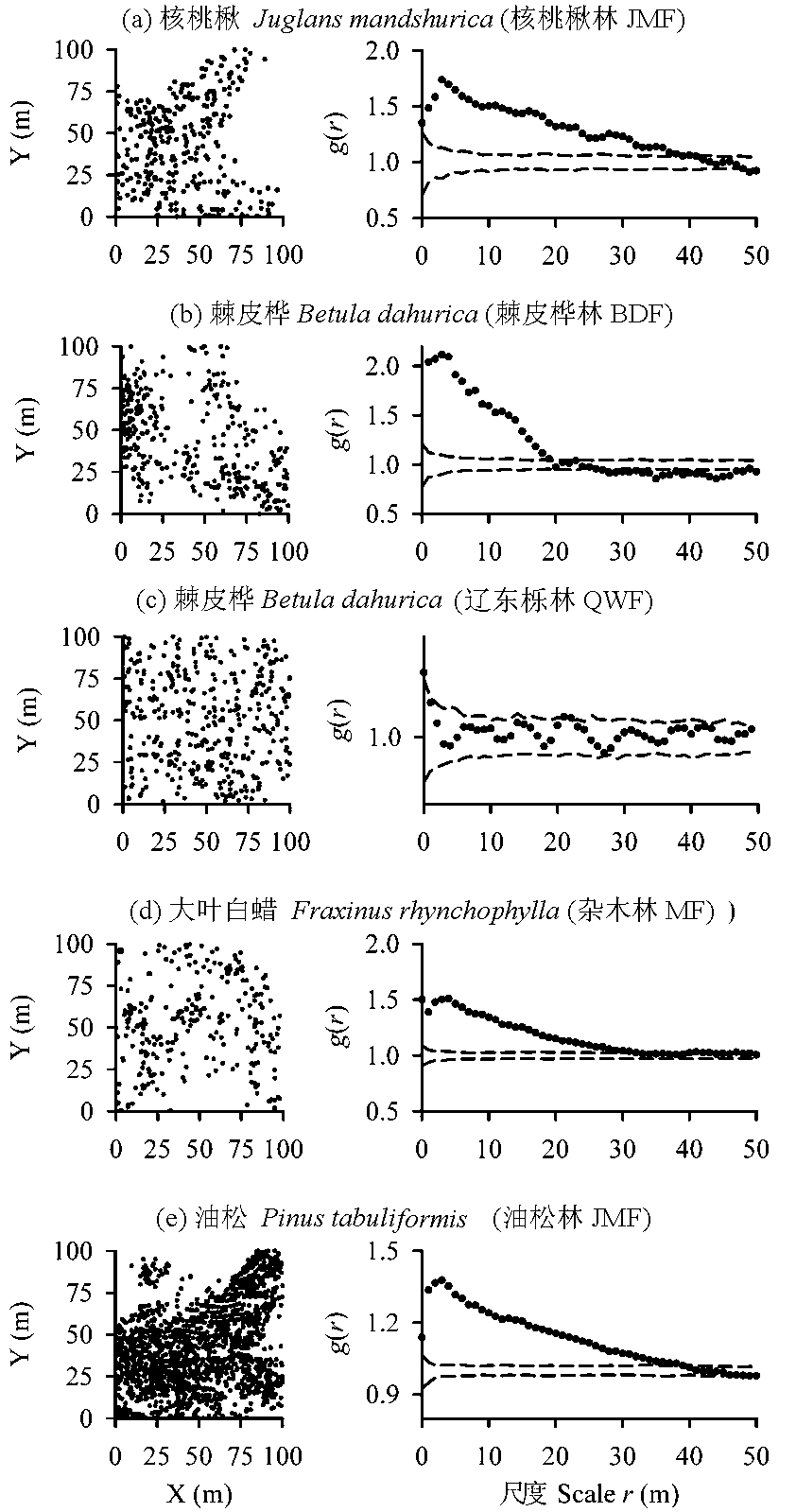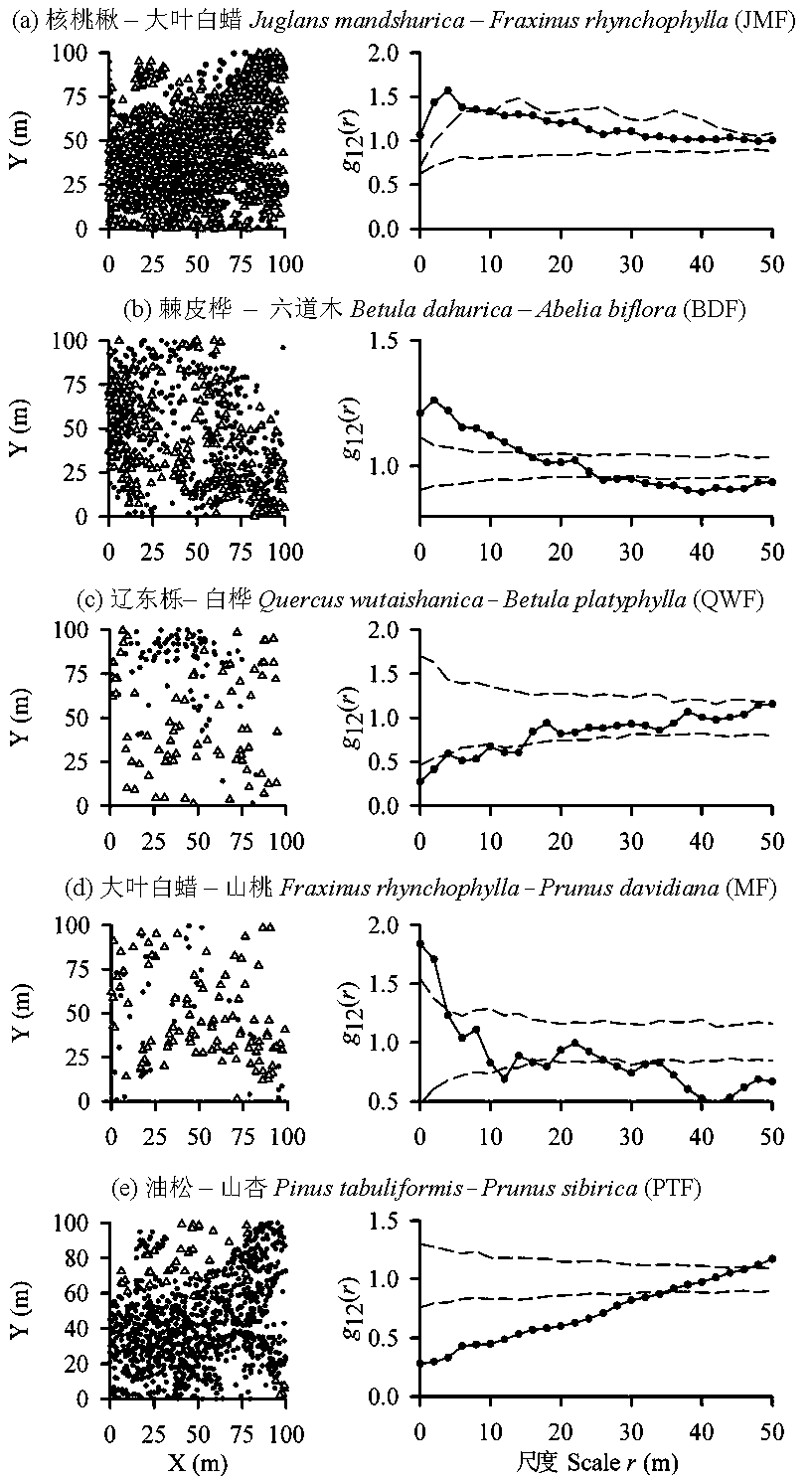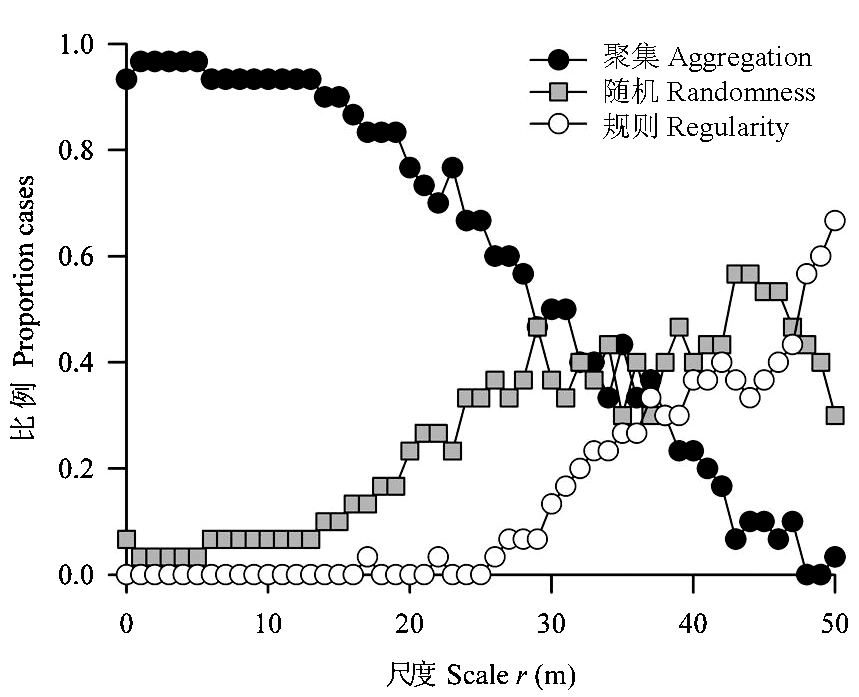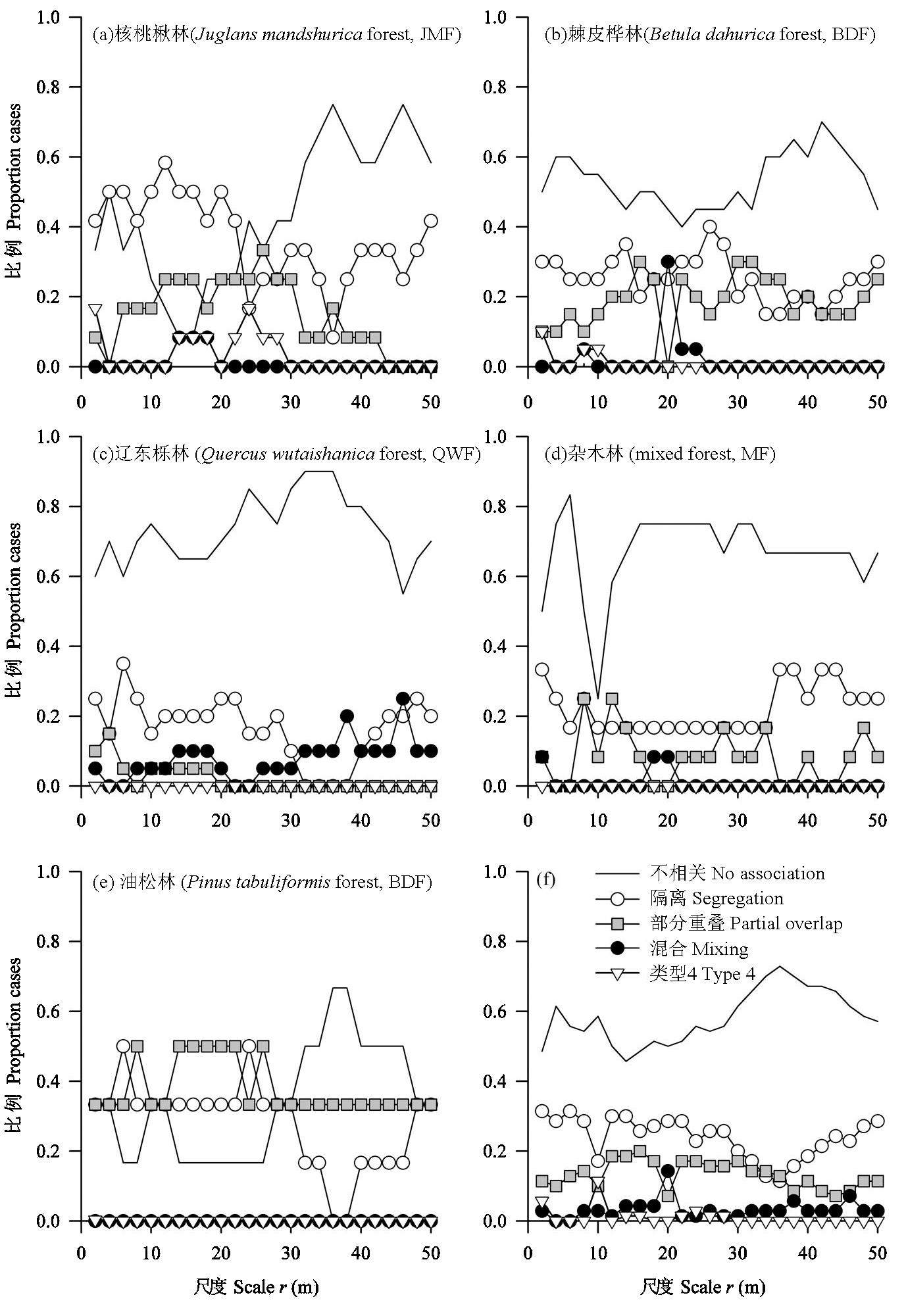



生物多样性 ›› 2011, Vol. 19 ›› Issue (2): 252-259. DOI: 10.3724/SP.J.1003.2011.08024 cstr: 32101.14.SP.J.1003.2011.08024
所属专题: 中国的森林生物多样性监测
祝燕1, 白帆1,2, 刘海丰1,3, 李文超1, 李亮1,2, 李广起1,2, 王顺忠1, 桑卫国1,*( )
)
收稿日期:2011-01-30
接受日期:2011-03-25
出版日期:2011-03-20
发布日期:2011-06-01
通讯作者:
桑卫国
作者简介:*E-mail: swg@ibcas.ac.cn基金资助:
Yan Zhu1, Fan Bai1,2, Haifeng Liu1,3, Wenchao Li1, Liang Li1,2, Guangqi Li1,2, Shunzhong Wang1, Weiguo Sang1,*( )
)
Received:2011-01-30
Accepted:2011-03-25
Online:2011-03-20
Published:2011-06-01
Contact:
Weiguo Sang
摘要:
种群分布格局和种间空间关联性研究有助于深入理解物种共存机制。本研究在北京地区5个1 ha典型暖温带森林样地, 在0-50 m尺度范围内综合分析了常见种的种群分布格局及成年树种间的空间关联性。研究发现: (1)所有检验的物种都表现了聚集格局, 主要发生在较小(0-15 m)的尺度范围内, 并且同种聚集强度峰值普遍出现在目标个体周围1 m的距离内; 在>15 m的较大尺度上, 随着尺度增加, 随机和规则格局成为物种分布的主要形式; (2) 种间不相关联的比例高(~50%), 即使种间存在显著的关联性, 也是以隔离和部分重叠为主要的关联形式; 很少的物种对(~4%)呈混合分布。种子扩散限制和生境异质性在某种程度上解释了种群普遍聚集的格局, 种群聚集分布又促使种间分布不相关联, 或者种间呈现隔离和部分重叠格局, 反映了物种分布与生境存在紧密的关联性。另外, 种间隔离的格局会阻止种间个体相互竞争。然而, 由于同种个体聚集分布, 密度制约成为调节种群分布的主要形式。本结果将有助于揭示森林群落物种共存的潜在维持机制。
祝燕, 白帆, 刘海丰, 李文超, 李亮, 李广起, 王顺忠, 桑卫国 (2011) 北京暖温带次生林种群分布格局与种间空间关联性. 生物多样性, 19, 252-259. DOI: 10.3724/SP.J.1003.2011.08024.
Yan Zhu, Fan Bai, Haifeng Liu, Wenchao Li, Liang Li, Guangqi Li, Shunzhong Wang, Weiguo Sang (2011) Population distribution patterns and interspecific spatial associations in warm temperate secondary forests, Beijing. Biodiversity Science, 19, 252-259. DOI: 10.3724/SP.J.1003.2011.08024.

图1 物种分布格局示意图。 用199个完全随机模拟值的第五最高值和第五最低值构建置信区间(虚线), 每个分析尺度上的双关联函数g(r)实测值用实心圆表示。
Fig. 1 Examples for analyzing population distribution patterns. The confidence limits (dashed lines) were constructed from the 5th-lowest and 5th-highest g(r) values of 199 simulations of a null model of complete spatial randomness. The solid circles denote the pair-correlation functions of the observed data over scale r.

图2 种间空间关联性分析示意图。 分布图中, 黑点代表物种1的位置, 三角符号代表物种2的位置; Monte Carlo随机模拟199次, 模拟值的第五最高值和第五最低值构建置信区间(虚线), 实心圆代表实测值。
Fig. 2 Examples for analyzing interspecific associations. Black points indicate locations of species 1 and triangles indicate locations of species 2. Dashed lines give the simulation envelopes of the 5th-lowest and 5th-highest values of the 199 Monte Carlo simulations under a null model of complete spatial randomness, and solid circles show the observed values at scales r.

图3 检验的所有物种在不同尺度上表现聚集、随机和规则分布格局的比例
Fig. 3 Proportion of all tested species showing patterns of significant aggregation, randomness and regularity at scales r.

图4 种间不同关联类型的物种对比例。 (a)、(b)、(c)、(d)和(e)图分别代表每个样地分析的结果,(f)图是5个样地累计70个物种对的分析结果。
Fig. 4 Proportion of different interspecific spatial association types. (a), (b), (c), (d), and (e) are the results of each forest plot. (f) is the overall assessment of all 70 species pairs analyzed in five forest plots.
| [1] |
Barot S, Gignoux J, Menaut JC (1999) Demography of a savanna palm tree: predictions from comprehensive spatial pattern analyses. Ecology, 80, 1987-2005.
DOI URL |
| [2] | Chen LZ (陈灵芝) (1992) The ordination and numerical classification of montane coniferous forests in warm-temperate region. Acta Phytoecologica et Geobotanica Sinica (植物生态学与地植物学报), 16, 301-310. (in Chinese with English abstract) |
| [3] | Chesson P, Neuhauser C (2002) Intraspecific aggregation and species coexistence—comment from Chesson and Neuhauser. Trends in Ecology and Evolution, 17, 210-211. |
| [4] |
Condit R, Hubbell SP, Foster RB (1992) Recruitment near conspecific adults and the maintenance of tree and shrub diversity in a neotropical forest. The American Naturalist, 140, 261-286.
URL PMID |
| [5] | Condit R, Hubbell SP, Foster RB (1994) Density-dependence in two understory tree species in a neotropical forest. Ecology, 75, 674-680. |
| [6] |
Condit R (1995) Research in large, long-term tropical forest plots. Trends in Ecology and Evolution, 10, 18-23.
DOI URL PMID |
| [7] | Connell JH (1971) On the role of natural enemies in preventing competitive exclusion in some marine animals and in rain forest trees. In: Dynamics of Populations (eds den Boer PJ, Gradwell GR), pp.298-312. Center for Agricultural Publishing and Documentation, Wageningen, the Netherl- ands. |
| [8] | Diggle PJ (1979) On parameter estimation and goodness-of-fit testing for spatial point patterns. Biometrics, 35, 87-101. |
| [9] | Diggle PJ (1981) Binary mosaics and the spatial pattern of heather. Biometrics, 37, 531-539. |
| [10] | Diggle PJ (2003) Statistical Analysis of Spatial Point Patterns, 2nd edn. Arnold, London. |
| [11] | Gavrikov V, Stoyan D (1995) The use of marked point processes in ecological and environmental forest studies. Environmental and Ecological Statistics, 2, 331-344. |
| [12] | Getzin S, Wiegand T, Wiegand K, He FL (2008) Heterogeneity influences spatial patterns and demographics in forest stands. Journal of Ecology, 96, 807-820. |
| [13] | Greig-Smith P (1983) Quantitative Plant Ecology, 3rd edn. Blackwell Scientific Publications, London. |
| [14] |
Harms KE, Wright JS, Calderón O, Hernandez A, Herre EA (2000) Pervasive density-dependent recruitment enhances seedling diversity in a tropical forest. Nature, 404, 493-495.
DOI URL PMID |
| [15] | He FL, Duncan RP (2000) Density-dependent effects on tree survival in an old-growth Douglas fir forest. Journal of Ecology, 88, 676-688. |
| [16] | He FL, Legendre P, LaFrankie JV (1997) Distribution patterns of tree species in a Malaysian tropical rain forest. Journal of Vegetation Science, 8, 105-114. |
| [17] | Hou JH (侯继华), Huang JH (黄建辉), Ma KP (马克平) (2004) Eleven-year population growth dynamic of major species in a Quercus liaotungensis forest in the Dongling Mountains, northern China. Acta Phytoecologica Sinica (植物生态学报), 28, 609-615. (in Chinese with English abstract) |
| [18] | Hou JH, Mi XC, Liu CR, Ma KP (2004) Spatial patterns and associations in a Quercus-Betula forest in northern China. Journal of Vegetation Science, 15, 407-414. |
| [19] |
Hubbell SP (1979) Tree dispersion, abundance, and diversity in a tropical dry forest. Science, 203, 1299-1309.
URL PMID |
| [20] | Hubbell SP, Foster RB (1983) Diversity of canopy trees in a neotropical forest and implications for the conservation of tropical trees. In: Tropical Rainforest Ecology and Management (eds Sutton SJ, Whitmore TC, Chadwick AC), pp. 314-329. Blackwell, Oxford. |
| [21] | Janzen DH (1970) Herbivores and the number of tree species in tropical forests. The American Naturalist, 104, 501-528. |
| [22] | Lai JS, Mi XC, Ren HB, Ma KP (2009) Species-habitat associations change in a subtropical forest of China. Journal of Vegetation Science, 20, 415-423. |
| [23] |
Legendre P, Mi XC, Ren HB, Ma KP, Yu MJ, Sun IF, He FL (2009) Partitioning beta diversity in a subtropical broad-leaved forest of China. Ecology, 90, 663-674.
URL PMID |
| [24] |
Lin YC, Chang LW, Yang KC, Wang HH, Sun IF (2011) Point patterns of tree distribution determined by habitat heterogeneity and dispersal limitation. Oecologia, 165, 175-184.
DOI URL PMID |
| [25] |
Loosmore NB, Ford ED (2006) Statistical inference using the G or K point pattern spatial statistics. Ecology, 87, 1925-1931.
URL PMID |
| [26] | Martínez I, Wiegand T, González-Taboad F, Obeso JR (2010) Spatial associations among tree species in a temperate forest community in North-western Spain. Forest Ecology and Management, 260, 456-465. |
| [27] | Murrell D, Purves D, Law R (2002) Intraspecific aggregation and species coexistence. Trends in Ecology and Evolution, 17, 211. |
| [28] | Peters HA (2003) Neighbour-regulated mortality: the influence of positive and negative density dependence on tree populations in species-rich tropical forests. Ecology Letters, 6, 757-765. |
| [29] |
Plotkin JB, Potts MD, Leslie N, Manokaran N, LaFrankie J, Ashton PS (2000) Species-area curves, spatial aggregation, and habitat specialization in tropical forests. Journal of Theoretical Biology, 207, 81-99.
DOI URL PMID |
| [30] | R Development Core Team (2009) R: A Language and Environment for Statistical Computing. R Foundation for Statistical Computing. http://www.r-project.org/. |
| [31] | Ripley BD (1976) The second-order analysis of stationary point processes. Journal of Applied Probability, 13, 255-266. |
| [32] | Ripley BD (1977) Modelling spatial patterns (with discussion). Journal of the Royal Statistical Society, Series B, 39, 172-212. |
| [33] |
Shen GC, Yu MJ, Hu XS, Mi XC, Ren HB, Sun IF, Ma KP (2009) Species-area relationships explained by the joint effects of dispersal limitation and habitat heterogeneity. Ecology, 90, 3033-3041.
DOI URL PMID |
| [34] | Sterner RW, Ribic CA, Schatz GE (1986) Testing for life historical changes in spatial patterns of four tropical tree species. Journal of Ecology, 74, 621-633. |
| [35] | Stoll P, Newbery DM (2005) Evidence of species-specific neighborhood effects in the Dipterocarpaceae of a Bornean rain forest. Ecology, 86, 3048-3062. |
| [36] | Tang ZY (唐志尧), Fang JY (方精云), Zhang L (张玲) (2004) Patterns of woody plant species diversity along environmental gradients on Mt. Taibai, Qinling Mountains. Biodiversity Science (生物多样性), 12, 115-122. (in Chinese with English abstract) |
| [37] | Wang X, Wiegand T, Hao ZQ, Li BH, Ye J, Lin F (2010) Species associations in an old-growth temperate forest in north-eastern China. Journal of Ecology, 98, 674-686. |
| [38] |
Wiegand T, Gunatilleke S, Gunatilleke N (2007) Species associations in a heterogeneous Sri Lankan dipterocarp forest. The American Naturalist, 170, E77-E95.
DOI URL PMID |
| [39] | Wiegand T, Moloney KA (2004) Rings, circles, and null-models for point pattern analysis in ecology. Oikos, 104, 209-229. |
| [40] | Wu ZY (吴征镒) (1980) Vegetation of China (中国植被). Science Press, Beijing. (in Chinese) |
| [41] | Zhou R (周睿), Ge JP (葛剑平), Yu B (于波), Liu LJ (刘丽娟), Wu JG (吴记贵) (2007) Simulation of forest dynamics at Songshan Mountain. Journal of Beijing Forestry University (北京林业大学学报), 29, 19-25. (in Chinese with English abstract) |
| [42] | Zhu Y (祝燕), Mi XC (米湘成), Ma KP (马克平) (2009) A mechanism of plant species coexistence: negative density-dependent hypothesis. Biodiversity Science (生物多样性), 17, 594-604. (in Chinese with English abstract) |
| [43] | Zhu Y, Mi XC, Ren HB, Ma KP (2010) Density dependence is prevalent in a heterogeneous subtropical forest. Oikos, 119, 109-119. |
| [1] | 曲锐, 左振君, 王有鑫, 张良键, 吴志刚, 乔秀娟, 王忠. 基于元素组的生物地球化学生态位及其在不同生态系统中的应用[J]. 生物多样性, 2024, 32(4): 23378-. |
| [2] | 吕晓波, 李东海, 杨小波, 张孟文. 红树林群落通过淹水时间及海水盐度的生态位分化实现物种共存[J]. 生物多样性, 2024, 32(3): 23302-. |
| [3] | 徐智超, 朱美慧, 毛子昆, 王绪高. 氮添加对东北温带阔叶红松林幼苗动态的影响[J]. 生物多样性, 2024, 32(12): 24255-. |
| [4] | 施国杉, 刘峰, 曹光宏, 陈典, 夏尚文, 邓云, 王彬, 杨效东, 林露湘. 西双版纳热带季节雨林木本植物的beta多样性: 空间、环境与林分结构的作用[J]. 生物多样性, 2024, 32(12): 24285-. |
| [5] | 张楚然, 李生发, 李逢昌, 唐志忠, 刘辉燕, 王丽红, 顾荣, 邓云, 张志明, 林露湘. 云南鸡足山亚热带半湿润常绿阔叶林20 ha动态监测样地木本植物生境关联与群落数量分类[J]. 生物多样性, 2024, 32(1): 23393-. |
| [6] | 杨舒涵, 王贺, 陈磊, 廖蓥飞, 严光, 伍一宁, 邹红菲. 松嫩平原异质生境对土壤线虫群落特征的影响[J]. 生物多样性, 2024, 32(1): 23295-. |
| [7] | 王明慧, 陈昭铨, 李帅锋, 黄小波, 郎学东, 胡子涵, 尚瑞广, 刘万德. 云南普洱季风常绿阔叶林不同种子扩散方式的优势种空间点格局分析[J]. 生物多样性, 2023, 31(9): 23147-. |
| [8] | 董廷玮, 黄美玲, 韦旭, 马硕, 岳衢, 刘文丽, 郑佳鑫, 王刚, 马蕊, 丁由中, 薄顺奇, 王正寰. 上海地区金线侧褶蛙种群的潜在空间分布格局及其景观连通性[J]. 生物多样性, 2023, 31(8): 22692-. |
| [9] | 公欣桐, 陈飞, 高欢欢, 习新强. 两种果蝇成虫与幼虫期的竞争及其对二者共存的影响[J]. 生物多样性, 2023, 31(8): 22603-. |
| [10] | 谢艳秋, 黄晖, 王春晓, 何雅琴, 江怡萱, 刘子琳, 邓传远, 郑郁善. 福建海岛滨海特有植物种-面积关系及物种丰富度决定因素[J]. 生物多样性, 2023, 31(5): 22345-. |
| [11] | 刘向, 刘木, 肖瑶. 叶片病原真菌对植物物种共存的影响: 进展与挑战[J]. 生物多样性, 2023, 31(2): 22525-. |
| [12] | 金恒镳. 从天择到人择: 在华莱士的肩膀上看地球的未来[J]. 生物多样性, 2023, 31(12): 23267-. |
| [13] | 罗恬, 俞方圆, 练琚愉, 王俊杰, 申健, 吴志峰, 叶万辉. 冠层垂直高度对植物叶片功能性状的影响: 以鼎湖山南亚热带常绿阔叶林为例[J]. 生物多样性, 2022, 30(5): 21414-. |
| [14] | 鲁梦珍, 曾馥平, 宋同清, 彭晚霞, 张浩, 苏樑, 刘坤平, 谭卫宁, 杜虎. 喀斯特常绿落叶阔叶林死亡个体空间分布格局及生境关联[J]. 生物多样性, 2022, 30(4): 21340-. |
| [15] | 曲梦君, 努尔依拉·阿巴拜克, 邹旭阁, 赵航, 朱威霖, 王健铭, 李景文. 地理距离和环境因子对阿拉善戈壁植物群落β多样性的影响[J]. 生物多样性, 2022, 30(11): 22029-. |
| 阅读次数 | ||||||
|
全文 |
|
|||||
|
摘要 |
|
|||||
备案号:京ICP备16067583号-7
Copyright © 2022 版权所有 《生物多样性》编辑部
地址: 北京香山南辛村20号, 邮编:100093
电话: 010-62836137, 62836665 E-mail: biodiversity@ibcas.ac.cn